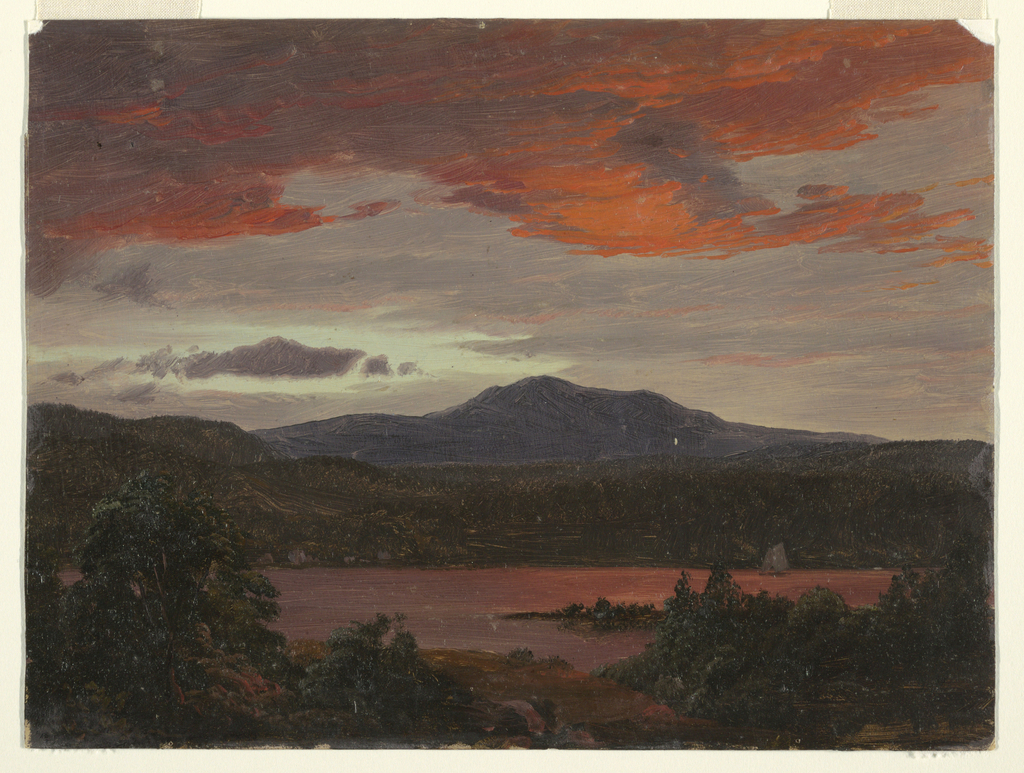“It is, indeed, a tribute to the appeal of the sheer granite walls of Katahdin that Church should have made so many studies of this region alone.”[1] -Myron Avery, writer and Maine adventurer
American landscape painter Frederic Edwin Church (American, 1826-1900) began visiting the region around Mt. Katahdin, Maine in 1852. While Church is renowned for his inexhaustible travels, both domestically and abroad, his faithfulness to the Pine Tree State and its famed geography forms a constant in the artist’s prolific career. Not only did he visit regularly, but he also sketched and painted rigorously, producing dozens of works.
In this 1853 oil study, Mount Katahdin from Lake Katahdin, Church stages the scene at sunset with the sky filled with fiery, neon salmon clouds. Beneath the sky is the cool rise of Mt. Katahdin in the distance, a forested landscape below, and finally Lake Katahdin, glowing pink with the reflection of the sky above. Although scale is difficult to comprehend in the image, the work is as striking as it is diminutive at about 9 by 12 inches. It was not one of Church’s large paintings, exhibited to crowds; it was, indeed, a study in oil paint, probably executed quickly and outside. His brush strokes are visible and paint application is uneven. While not devoid of details, it is apparent that this study is less about the minutia of the scene than it is about color, shadow, and overall effect. Church is capturing that particular moment when a vibrant sunset passes over a beautiful landscape.
As has often been written, the 19th century was the pinnacle of the “en plein air sketch,” portable studies executed by artists while they were out in a landscape, which they subsequently brought back into their studios to work up into larger, finished works.[2] For Church, these en plein air studies and sketches came naturally—he was an avid traveler who voyaged with like-minded writers, artists, and intellectuals. The urge to gather, record, and study was an outgrowth of the scientific bent of the mid-19th century (On the Origin of Species was published in 1859) and it was the inevitable result of improved modes of transportation—from trains to steamships, but it was also an extension of Manifest Destiny and the urge to see what had yet to be seen.
Church’s many depictions of Katahdin over the years suggest these varied impulses to capture and celebrate the wonders of untamed landscapes. Whether his focus is centered on color, as in this sketch, or geology, as in others, Church was meticulous in recording details in his scenes. Now the terminus of the Appalachian Trail, Katahdin and its environs continue to inspire.
[1] Myron Avery, Artists and Katahdin, (Bangor, Maine: Bangor and Aroostook Railroad Co., 1940).
[2] Andrew Wilton, “Frederic Edwin Church” in Frederic Church and the Landscape Oil Sketch, (London: National Gallery Company, 2013).
Caroline O’Connell is the Collections Assistant in the Drawings, Prints & Graphic Design Department at Cooper Hewitt, Smithsonian Design Museum.
